Systemic Criteria for the Analysis of Alpha- and Gamma-Diversity of Freshwater Algae-Juniper Publishers
Juniper Publishers- Open Access Journal of Environmental Sciences & Natural Resources
Systemic Criteria for the Analysis of Alpha- and Gamma-Diversity of Freshwater Algae
Authored by Sophia Barinova
Abstract
Paper represented the new approach for assessment of the algal floras species list completeness for followed taxonomic structure and comparative floristic analysis. It was first experience for constructing curves of distribution of species in the genera over the number of algal genera, as was early doing by J.C. Willis in the book Age and Area in 1922 for different lists of faunas and angiosperm floras. We revealed that Willis curves that constructed for algal floras of diverse aquatic objects of Eurasia are represented by hyperbolic distribution (in Logarithmic coordinates as a straight line) and can be used as criteria for the algal floras list completeness for comparative floristic analysis of alpha- or gamma-diversity.
Keywords: Algae; Flora; Species list; Comparative floristic; Eurasia
Introduction
The diversity of algae of a certain territory includes a number of spatial units, phytochoria [1], which are mutually subordinate according to a hierarchical principle, the highest of which is the biosphere (gamma-diversity], and the lowest one is the flora, algal flora of a particular water body (alpha-diversity]. The taxonomic composition of any phytochoria was formed as a result and under the influence of the conditions that existed on the phytochoric territory during the evolution of its biodiversity (Figure 1]. The hierarchical order of phytochoria suggests that the patterns revealed at the lower levels reflect the general patterns of phytochoria of a higher rank. The aim of study was to choose the criteria for the analysis of species list completeness for followed comparative floristic of algal floras [2].
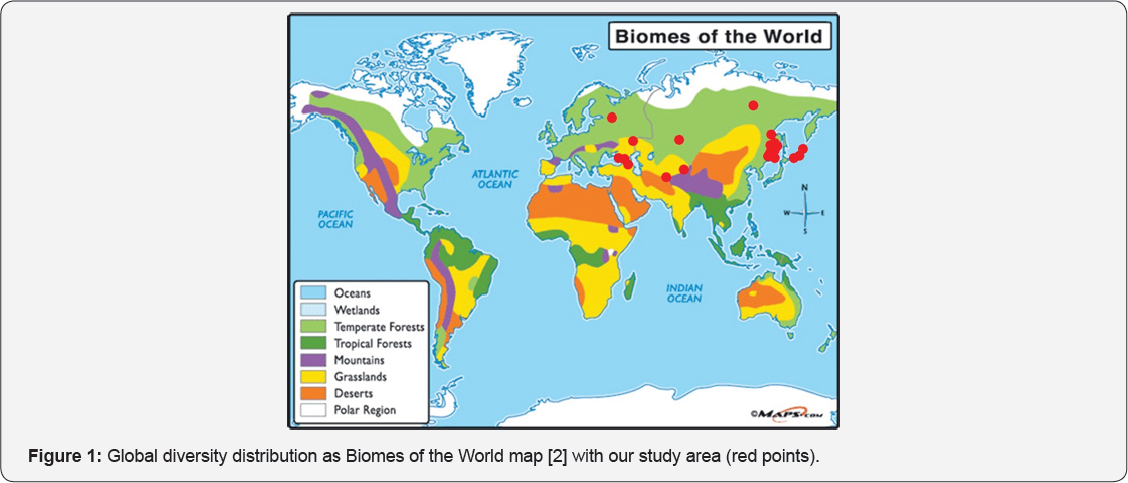
Methods
For a hierarchical diversity of algae, in our opinion, the following sequence is possible:
i. Community (species in the sample); community at a river or lake station (a collection of species in samples from a particular station);
ii. Community of a section of a river or a section of its basin (set of species in samples from stations of a particular section of the river), alpha-diversity;
iii. Flora of a small river (a set of species in samples from the stations of the river and its basin), alpha-diversity;
iv. Flora of the river basin (a set of species in samples from river and small river basins of its basin), alpha-diversity;
v. Flora of a large territory, administrative unit or landscape-economic site (a set of species in samples from water bodies of this territory), gamma-diversity;
vi. Flora of phytochoria (a set of species found on the territory homogeneous in the climatic relation), gamma- diversity;
vii. Flora of the biosphere.
Studies of algal flora (alpha-diversity) that can be determine as a set of species and as a system of interacting and conjugate evolving species populations [3] begin with an assessment of the available species composition. The first action before starting the analysis of algal flora as its constituent species list is the determination of the quality of the available set of species.
That is, it is necessary to understand whether the species composition that is obtained as a result of field research and taxonomic identification is sufficiently representative for the flora of the territory. It is usually assumed that a list of algae that has been collected for several years, including all-season sampling, is suitable for floristic analysis. However, the sufficiency criteria for the analysis of the available species composition are not yet available, except that at subsequent observations in the slides new taxa do not appear.
Algal floras develop over tens and hundreds of years, so a one-moment sampling results may not be sufficient for an adequate assessment. From this point of view, the greatest interest is represented by algal flora, studied for ten or more years, especially if the observation was conducted from the time of the formation, when it is possible to trace in detail and in a complex manner the process of development of algal flora of a new water body. The above definition of the flora shows its systemic character [4]. It is based on the systemic nature of the flora. We tried to find the criteria for sufficiency of the list of species for analysis. The first step in this way was to check the identified species composition of algae for completeness.
Analysis of Algal Species Lists Data in the Diverse Aquatic Habitats
In other words, it was necessary to establish whether the algae list constituted a system. The criterion of systemic nature of species list for algal floristic studies suggests of compliance with the law of Willis [5-7]. J.C. Willis show of his research results in outstanding book Age and Area [8,9] where he established the low: in well-studied flora and fauna, the distribution of the number of species according to the number of genera is regular and graphically expressed as a hyperbola (in Logarithmic coordinates - straight line). He said: "It is clear that this type of distribution of the genera by the number of their contained species is a perfectly general phenomenon. There are no exceptions", and demonstrated it in his picture of "Mixed curves" on page 237. We are tried to implement in first the Willis law to the algal floras of diverse water bodies and regions [5, 7,10].
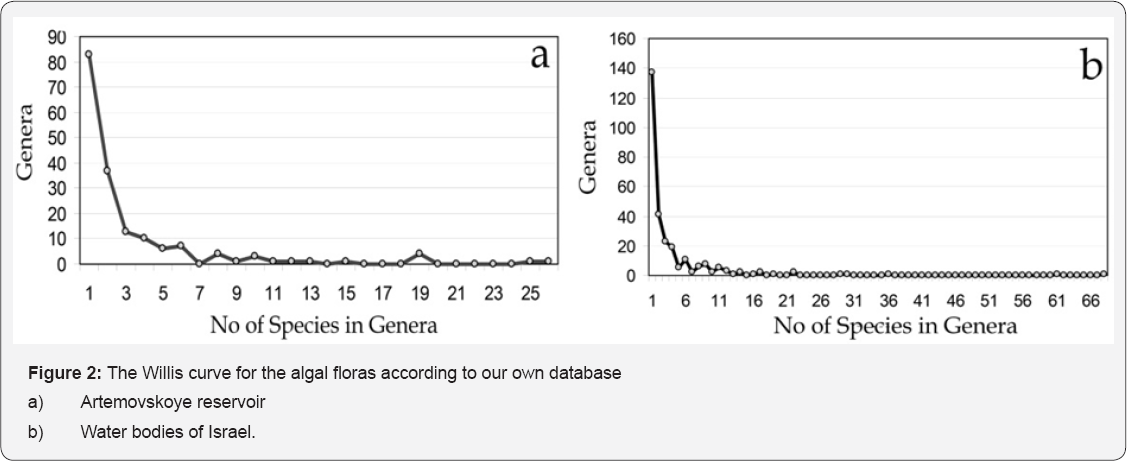
As can be seen in Figure 2, the well-studied algal flora of the Artemovskoye reservoir is completely subject to the distribution of Willis, and, consequently, constitutes a system that can be analyzed from the standpoint of system analysis, characterizing the qualitative parameters (taxonomic composition, species richness), structural indicators such as species diversity, and its dynamics. The same we can see in Figure 1b where the Willis curve also close to hyperbolic and therefore algal flora of Israel can be analyzed as a system. The algal flora of the Artemovskoye reservoir is a fairly well-studied flora, its species composition is almost close to saturation, since it was monitored monthly for 14 years. Such well-studied algal flora on the territory of Eurasia is rather rare. Usually it is a reservoir for drinking purposes. Most often, water bodies or territories are subjected to a study of the species composition for a short period of time, three to five years, and therefore, even if one tries to select the largest species composition possible, the completeness of the list is not achieved.
An important point in floristic research is the holding of all-season sampling, which is also not always achieved, and therefore some of the species spectrum of the flora is certainly beyond the scope of the study. Usually, specialists of various specialties and with different purposes carry out determination of the species composition of algae in a water body. This aspect in research also leaves an imprint on the quality of the sample of floral composition. If collections and species definitions are conducted for taxonomic purposes, then most often the greatest attention is paid to specific taxa or group of taxa under study, and the rest of the species composition is not fully selected or ignored. If the goal of the work is hydrobiological then the definitions are usually conducted to higher taxa than the species, attention is paid to mass species, the species composition is ectopically heterogeneously chosen.
There is one more aspect in working with the species composition of algae - the thoroughness of defined species in the sample. To achieve maximum results in determining the species composition of the flora, it is necessary to apply all possible methods of collection and processing of the sample, allowing us to choose the maximum species richness. In addition, it is necessary to repeatedly microscope the samples from the sample to reach a state where no new species appear. In all these cases, the result of the expert's work is the list of algal flora species, but to this day, there have not been formed sufficiently objective methods to determine the suitability of the identified list for adequate floristic and comparative floristic analyzes.
When dealing with a specific species list, a specialist cannot always determine whether a foreign list is suitable for comparison with the algal flora obtained based on his own study. In our opinion, it is possible to objectify such an assessment with the help of the dependence of Willis, whose work on the well-studied species composition of the algae of the Artemovskoye reservoir was demonstrated above. We tried to collect heterogeneous, differently defined and published species lists, attracted lists from our personal work and works in coauthorship. Algal flora for comparative analysis of the Willis criteria conformity was taken from either specific water bodies or watercourses and for systems of water bodies or territories where water bodies of different basins are located, such as, for example, some protected areas [11-31].
Each used list of species was previously taxonomically unified taking into account modern concepts of taxonomy and taxonomy of the species in it. Based on unified lists, a database was compiled and graphical dependencies of the distribution of the number of species of each algal flora by the number of genera were constructed, that is, the dependences of Willis for algal floras were constructed. Figures 3 & 4 show that the dependence of Willis in a general form is observed for all the lists shown. This is a result of the reflection of the specifics of microalgae of continental waters - they are single-celled microscopic organisms with high rates of reproduction and therefore practically any, sufficiently large number of samples studied gives an adequate Willis distribution. However, on the graphs constructed by us, we can distinguish a number of exactly hyperbolic ones, and the others, where the curve does not have a smooth fall. Let us consider, in which cases.
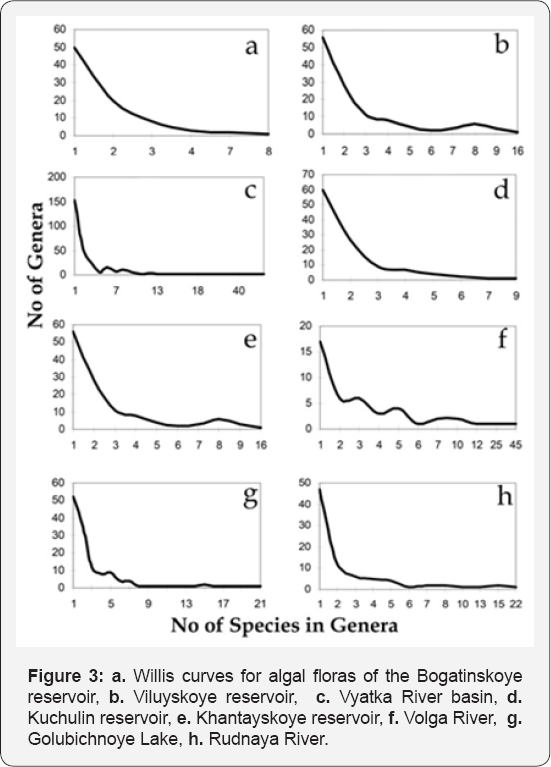
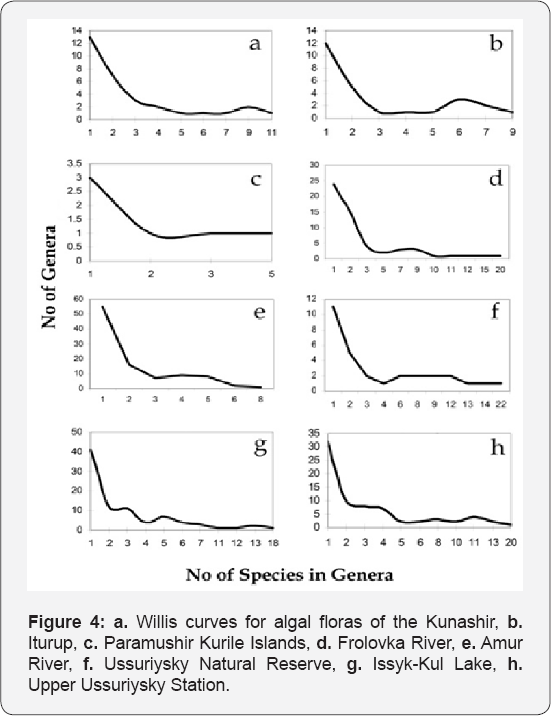
The smooth dependence of Willis is observed in such well- studied algae floras as in the Bogatinskoye and Kuchulinskoye reservoirs of the Primorye district of Russian Far East, and Vilyuiskoye reservoir in Yakutia. This is all the "man-made" lakes-reservoirs created by man for certain purposes, more often - drinking, and therefore attracting special attention to algologists for water quality monitors purposes. Their floras have been studied for dozens of years with a regular selection of samples in all seasons, with special attention paid to phytoplankton, qualitative studies and quantitative samples were studied with sedimentogravimetric method, which also revealed nanoplanktonic species of algae.
Another group on the study of algal floras can be identified on the basis of graphs from the Figures 3 & 4 with a more or less bent curve, but not having a smooth dip as hyperblolic. These are the floras of most of the studied reservoirs, watercourses or territories: the Golubichnoye, Khantaiskoye reservoirs and Issyk-Kul Lake, Rudnaya, Frolovka, and Amur rivers, and territorial freshwater algal floras - Vyatka, Upper Ussuriysky Station, and Kunashir Kurile Island. For each of these algal floras there are reasons for the unevenness of the Willis curve. Flora of algae of the Upper Ussuriysky Station, Kunashir Kurile Island, rivers Amur and Frolovka - sporadic collections during the summer season only. For algal floras of the Issyk-Kul Lake and Khantayskoye reservoir - a study for hydrobiological purposes.The territory of the Ussuriysky Natural Reserve was expanded in the last year of research and the list included species from a little-studied territory as well.
In the basin of the Vyatka River were studied not only freshwater, but also terrestrial habitats. The Rudnaya River is a watercourse that is under the strong anthropogenic influence of the discharges of the industrial complex, and discharges are periodically accidental, therefore changes in the composition of the algal flora at different times during a long period of research are noticeable. The last group can be made up of curves that differ considerably from the hyperbola. Distributions for lists of algae from the Paramushir and Iturup Kurile Islands - are compiled on the basis of one-time sampling in one season. Species composition of plankton of the Volga River is defined, although on the basis of repeated voyages along the river, but on samples of plankton collected on membrane filters only. In such a large river, to a fairly planktonic species, which form the main part of the species list, a fair amount of torn off attached and raised from the bottom of forms from fouling and benthos is mixed. They cannot be considered as living in the water column, that is, they do not constitute a system of planktonic ecotype. However, these species cannot represent the submerged ecotopes also because it is accidentally finding. As a result, full algal flora is not represented in the studied list.
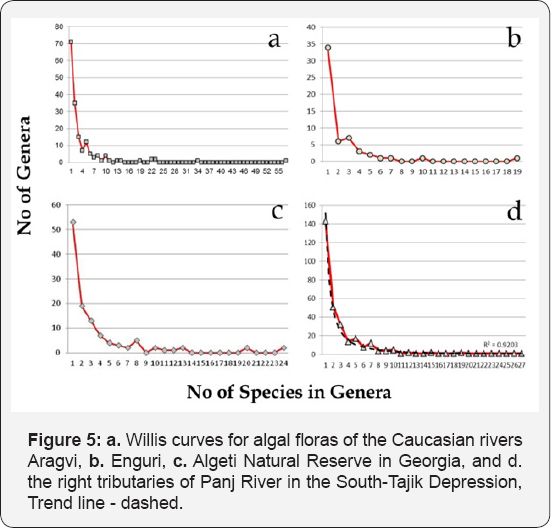
Last examples of the Willis curve constructing are shown on the Figure 5. We extracted these four algal floras because its species lists are very large, about thousand taxa [32-36]. Can be seen, that Willis curves constructed for large floras are most similar to hyperbolic such as demonstrated for the South- Tajik Depression algal flora distribution trend line (Figure 5d). Based on the results of the analysis of the distribution of the number of algal species by the number of genera for freshwater algal floras, we can conclude that the Willis curve is a tool that objectively identifies the quality, uniformity and adequacy of the algal flora species composition and its suitability for floristic and comparative floristic analyzes.
Conclusion
In conclusion should be noted, however, that the Willis curve is not, in our opinion, a criterion for floristic completeness of species composition [37]. Even in long-term studied algal floras, such as the algal flora of the Artemovskoye reservoir (14 years of monthly monitoring), the curve has deviations from the hyperbola, if the list included species from the mouths of inflowing tributaries and the spring. Thus, the compliance with the Willis criterion should be checked lists of taxa related either to one type of water body (alpha-diversity) or to a large area (gamma-diversity).
For more articles in Open Access Journal of Environmental Sciences & Natural Resources please click on: https://juniperpublishers.com/ijesnr/index.php



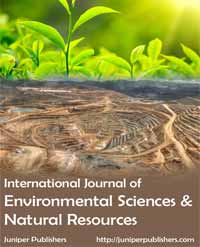
Comments
Post a Comment